FLNP JINR scientists discovered new magnetic phenomena in heterostructures
News, 14 August 2023
Applying the method developed at JINR, scientists of the Laboratory of Neutron Physics managed to detect a number of new magnetic phenomena, which were not previously predicted. The phenomena are connected with the interaction of superconducting and ferromagnetic order parameters. These studies can give great practical results in the development of such areas as superconducting spintronics, nanoelectronics, and superconducting quantum computing. In addition, employing rare–earth elements that they had not previously used, namely dysprosium and holmium, scientists managed to obtain a non-trivial magnetic ordering in layered structures, which gives excellent prospects for obtaining innovative materials.
The creation of devices for these new fields of knowledge is based on the research of ferromagnetic superconducting (FS) heterostructures. Today, neuromorphic calculations are becoming very relevant, for which artificial neurons are created based on contacts in which there are superconductor–ferromagnetic transitions. Detailed studies of FS heterostructures in wide ranges of changes in the magnetic field and temperature have been carried out in FLNP JINR for twenty years. Based on these works, JINR scientists developed a method of polarised neutron reflectometry, which formed the basis for the research of the scientific group of the Joint Institute.
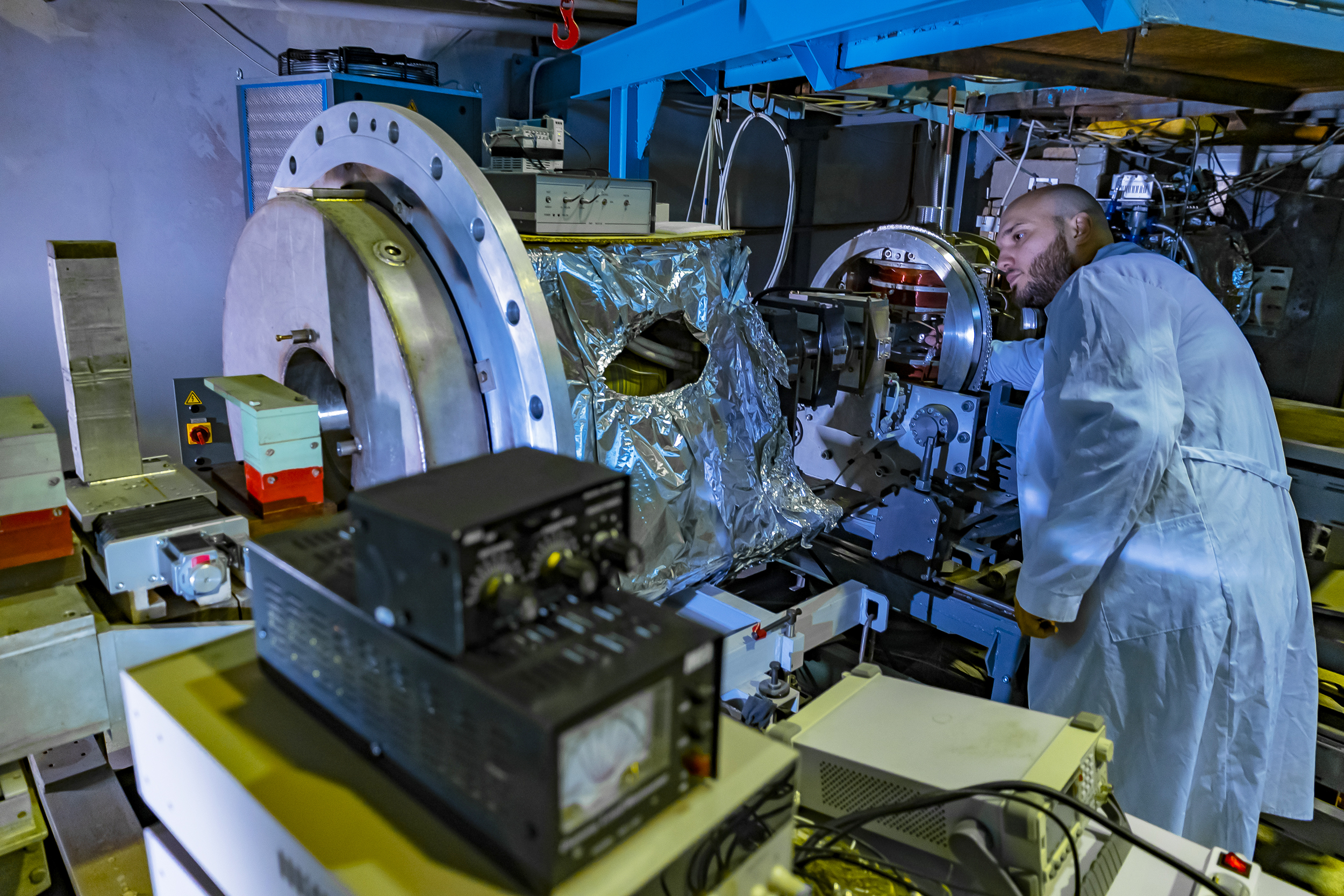 Co-author of the research Vladimir Zhaketov at work at the REMUR spectrometer
Co-author of the research Vladimir Zhaketov at work at the REMUR spectrometer
Superconductivity and ferromagnetism are antagonistic phenomena, their magnetic properties are opposite. A superconductor is a type of material in which an electric current flows without resistance. A ferromagnet is a magnetised material that creates a magnetic field in the volume. The magnetic field of a ferromagnet is capable of breaking superconducting electron pairs, thus destroying superconductivity. If a superconductor is positioned in a magnetic field, the field is completely expelled from it. This phenomenon is known as the Meissner effect. However, as you can see from the research, if the coexistence of these two phenomena is realised at the nanoscale, various unusual effects will arise. This is realised in heterostructures, i.e. structures consisting of very thin layers of various materials, where the thickness of each layer ranges from one to ten nanometers. “In a heterostructure, superconductivity can penetrate a ferromagnet and, vice versa, ferromagnetism can penetrate a superconductor, resulting in various non-trivial phenomena. This makes it possible to create devices with double coding. With the help of magnetism, it is possible to control superconducting properties, and with the help of superconductivity, i.e. temperature, to control magnetic properties,” a co–author of the study and a researcher at the REMUR group of the FLNP JINR Sector of Neutron Optics Vladimir Zhaketov said.
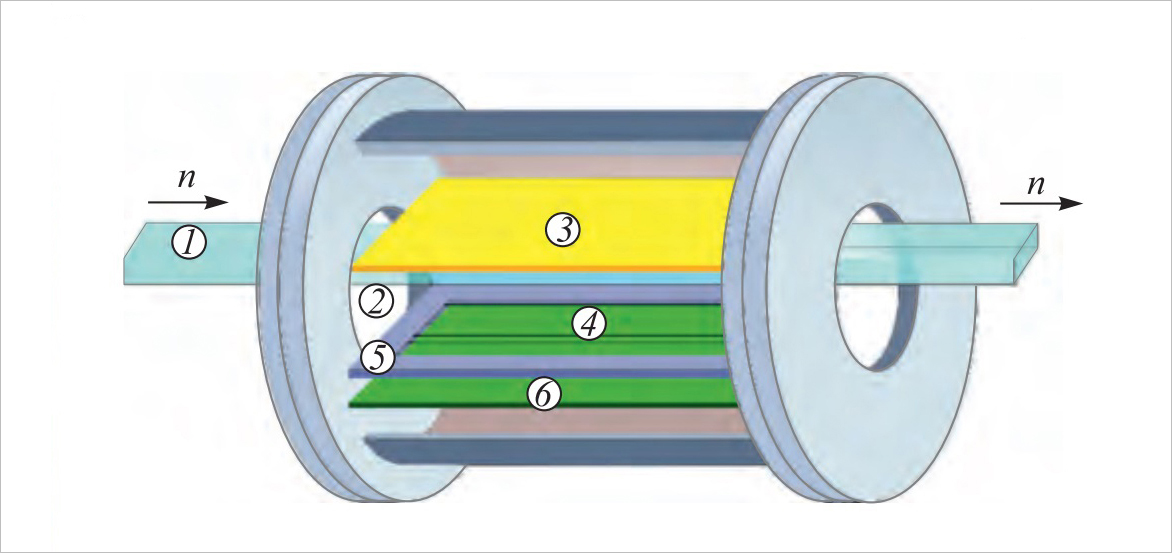 Scheme of the REMUR ionisation chamber: 1 — neutron beam; 2 — input and output windows; 3 — cathode; 4 — grid; 5 — grid frame; 6 — collector (anode)
Scheme of the REMUR ionisation chamber: 1 — neutron beam; 2 — input and output windows; 3 — cathode; 4 — grid; 5 — grid frame; 6 — collector (anode)
He said that a total of 18 types of layered structures were studied. Many of them contained ferromagnets of the transition metal group. For example, iron is a transition metal and at the same time a very strong ferromagnet. Studies have shown that the iron layer is to be “diluted” with a non-magnetic material to weaken its effect on the superconductor. In addition to this, structures with iron content are heterogeneous, forming clusters, so called “islands”, instead of smooth layers. This is a mistake of most experimentally created heterostructures, which demonstrates the relevance of conducting theoretical studies of FS structures with inhomogeneous layers that are currently absent. “Besides the fact that we are dealing with the physics of magnetism and the physics of superconductivity, which in itself is very difficult, the physics of inhomogeneous systems also interferes with the process. We are talking about the phenomena of superparamagnetism, the superspin-glass state. This greatly changes the overall picture,” Vladimir Zhaketov commented.
Recent work of the cycle was carried out with another ferromagnet, gadolinium, belonging to the group of rare–earth elements and showing weak ferromagnetic properties due to the low Curie temperature (about 12 °C), the temperature above which the material loses its magnetic properties. “It is important to note that in such structures, ferromagnetism is usually stronger than superconductivity. Ferromagnetism can suppress and destroy superconductivity. Therefore, it is necessary to weaken ferromagnetism by various approaches to equalise the exchange interaction between them,” the scientist highlighted. FLNP scientists studied the interaction of gadolinium layers with layers of the superconductor niobium. Another advantage of gadolinium is that it practically does not penetrate into niobium, and the boundaries of the niobium – gadolinium sections are sharp. At the same time, it is important to initially create a good, homogeneous structure without roughness. “In general, weak rare–earth ferromagnets penetrate into the surrounding material much less than ferromagnets of the transition group. Iron, cobalt, nickel, all these elements are strongly dissolved in niobium,” Vladimir Zhaketov noted. Two scientific articles on the effects arising in heterostructures containing gadolinium were published in the Physical Review B journal [12], [13].
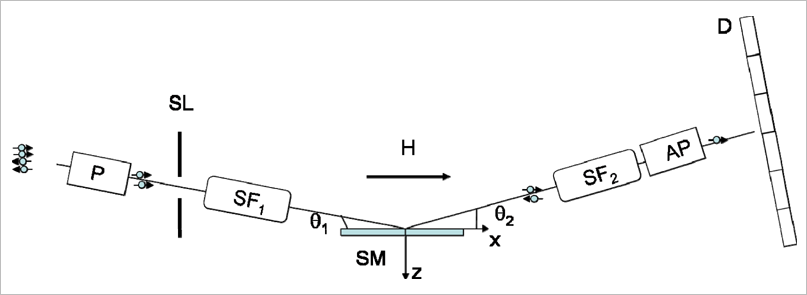 REMUR pilot scheme: P – polariser, SL – slit, SF1(2) – spin flippers, H – external magnetic field, SM – sample, AP – polarisation analyser, D – detector
REMUR pilot scheme: P – polariser, SL – slit, SF1(2) – spin flippers, H – external magnetic field, SM – sample, AP – polarisation analyser, D – detector
In superconducting ferromagnetic structures, FLNP JINR scientists discovered the manifestation of the following phenomena: cryptoferromagnetism, spin-triplet Cooper pairing, spontaneous vortex phase, and the inverse proximity effect, i.e. magnetisation of the superconducting layer.
The method of polarised neutron reflectometry was created and is being developed at JINR at the REMUR spectrometer, one of the scientific facility of the IBR-2 Reactor. This method of studying magnetic heterostructures makes it possible to determine the distribution of magnetisation and optical potential in the depth of the structure. The essence of the method is that the collimated neutron beam falls on the sample at an angle and is reflected. Scientists record the reflected beam and measure the dependence of the reflection coefficient on the transmitted wave vector. “Then scientists process this dependence, adjust the theoretical calculation to the experimental dependence, determine various parameters of the structure. This is a very powerful method aimed at the study of nanoscale ferromagnetism,” Vladimir Zhaketov highlighted. He explained that the method of neutron reflectometry had an advantage over the widespread X–ray reflectometry. Unlike X-rays, neutrons allow scientists to study magnetic phenomena in materials, and X-rays allow studying only structural properties. “The presence of a magnetic moment in the neutron is used here. Roughly speaking, in a magnetic field, a neutron can have two spin states: the spin of the neutron is aligned either with or against the magnetic field. We can prepare either one or the other spin state and reflect these neutron beams from the structure under study. When reflected from the structure, the neutron can keep its spin, or it can flip. Spin—reversal neutrons make it possible to study a non-collinear magnetic system with a complex magnetic ordering,” the scientist said.
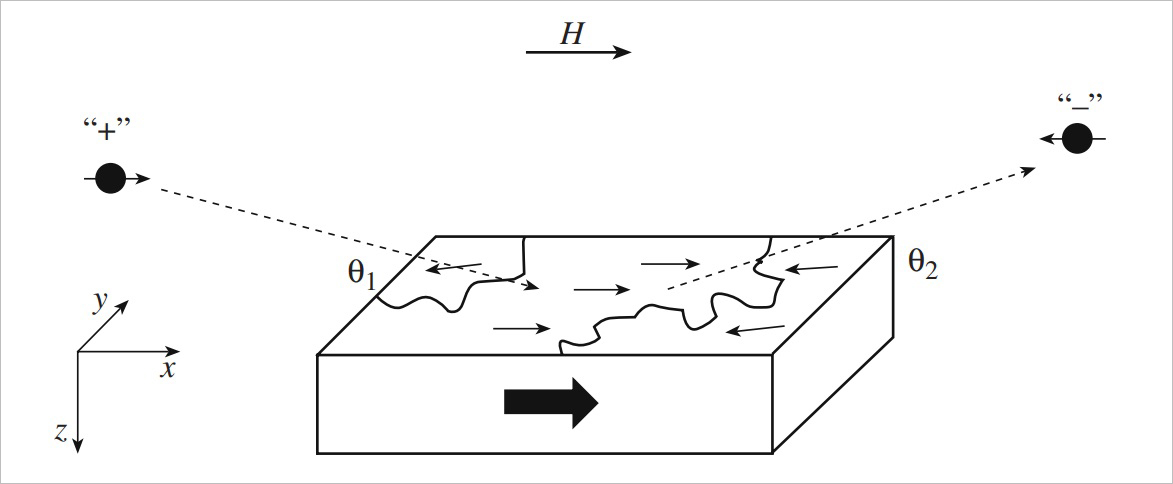 Scheme of an experiment on the reflectometry of polarised neutrons in an inhomogeneous magnetic field. The direction and value of the local magnetisation M(x,y) and its average value M(z) are shown on the upper and lateral faces, respectively
Scheme of an experiment on the reflectometry of polarised neutrons in an inhomogeneous magnetic field. The direction and value of the local magnetisation M(x,y) and its average value M(z) are shown on the upper and lateral faces, respectively
In studies of FS heterostructures, a group of FLNP JINR scientists also used complementary methods, namely X-ray scattering, SQUID magnetometry, resistive measurements, in which the dependence of the resistance of the structure on temperature is determined, secondary neutral mass spectrometry. Polarised neutron reflectometry will gradually replace some of these methods. Additional modes of secondary radiation registration are being developed at the REMUR facility. It will allow carrying out an elemental analysis of the structure. In one neutron experiment it will be possible to obtain much more necessary information.
Studies of superconducting and magnetic nanosystems using neutron scattering are continuing. Scientists are analysing the experimental data that were obtained before the shutdown of the IBR-2 Reactor in 2021. The REMUR facility is being modernised, options for further experiments are being considered.
For the series of works “Magnetism in ferromagnetic superconducting inhomogeneous layered structures”, a team of authors, namely Viktor Aksenov, Vladimir Zhaketov, Yuri Nikitenko, Alexander Petrenko (FLNP JINR), and Yuri Khaydukov (SINP MSU), was awarded the 2022 JINR Second Prize in the Experimental Physics Research nomination.
This cycle of work did not include a study in which layers of other rare-earth elements, namely dysprosium and holmium, were used instead of gadolinium. An article on this work was published in the Physics of the Solid State journal in 2023 (volume 65, issue 7). The magnetism of these elements is even weaker, and these magnets have a non-trivial magnetic order and a helicoidal magnetic structure. Heterostructures based on dysprosium and holmium require further study, including using additional methods. Magnetometric measurements of the samples will be carried out at the Institute of Metal Physics of the RAS Ural Branch (IMP) in Yekaterinburg. FLNP JINR closely cooperates with IMP, which has considerable experience in working with rare-earth elements. After the reactor operation is resumed, scientists will additionally carry out a layer-by-layer magnetic analysis of FS structures containing dysprosium and holmium. “This complex magnetic system is more transparent to superconductivity. Superconductivity will be easier to penetrate there, and even more interesting effects are expected in it,” Vladimir Zhaketov summed up.
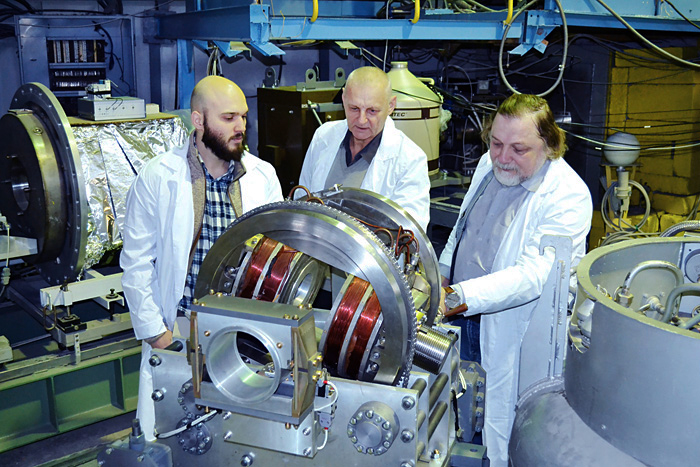 Research participants (from left to right): Vladimir Zhaketov, Yuri Nikitenko, and Alexander Petrenko
Research participants (from left to right): Vladimir Zhaketov, Yuri Nikitenko, and Alexander Petrenko
Publications
- V. L. Aksenov, K. N. Jernenkov, Yu. N. Khaidukov, Yu. V. Nikitenko, A. V. Petrenko, V. V. Proglyado, G. Andersson, R. Wappling, Interplay between superconductivity and ferromagnetism in Fe/V multilayered structure studied by polarized neutron reflectometry, Physica B 356 (2005) 9-13. DOI: 10.1016/j.physb.2004.10.036 .
- V. L. Aksenov, Yu.V. Nikitenko, A.V. Petrenko, V. M. Uzdin, Yu. N. Khaydukov, H. Zabel “Features of the magnetic state of the layered nanostructure ferromagnet-superconductor Fe-V” . “Crystallography”, 2007, volume 52, No. 3, pp. 403 – 409.
- V. L. Aksenov, Yu.V. Nikitenko, Y. N. Khaydukov, S. N. Vdovichev, M. M. Borisov, A. N. Morkovin, E. H. Mukhamedzhanov “Coexistence of superconductivity and ferromagnetism in the nanostructure Nb(50nm)/Fe(3.9nm)/40x[Si(3.4nm)/Mo(3.4nm)]/Si”, “Journal of Surface Investigation: X-ray, Synchrotron and Neutron Techniques”, 2009, No. 7, pp. 3 – 8.
- V. L. Aksenov, Yu. N. Khaidukov, Yu. V. Nikitenko, Peculiarities of magnetic states in Ferromagnet/Superconductor heterostructures due to the proximity effects. Journal of Physics: Conference Series 211, 012022 (2010). DOI: 10.1088/1742-6596/211/1/012022
- Khaydukov Yu. N., Aksenov V. L., Nikitenko Yu. V. et al. Proximity Effects in S/F Single Bilayer, J. Supercond. Novel Magnetic Magn., Vol. 24 (2011), p. 961 – 964. DOI: 10.1007/s10948-010-1041-0
- Yu. N. Khaidukov, N. S. Perov, M. M. Borisov, E. Kh. Mukhamedzhanov, A. Csik, K. N. Zhernenkov , Yu. V. Nikitenko, V. L. Aksenov, Structural and magnetic properties of the periodic 10х[Fe(5nm)/V(5nm)] and 20х[Fe(3nm)/V(3nm)] systems, Solid State Phenomena Vol. 190 (2012) pp. 396-400. DOI: 10.4028/www.scientific.net/SSP.190.396
- Yu. N. Khaidukov, D. Nagy, J.-H. Kim, T. Keller, A. Ruhm, Yu. V. Nikitenko, K. N. Zhernenkov, J. Stahn, L. F. Kiss, A. Csik, L. Bottyan, V. L. Aksenov, ”On the Feasibility to Study Inverse Proximity Effect in a Single S/F Bilayer by Polarized Neutron Reflectometry”, JETP Letters, 2013, Vol. 98, No.2, pp. 107 – 110.
- V. D. Zhaketov, D. I. Nikitenko, F. Radu, A. V. Petrenko, A. Chik, M. M. Borisov, E. H. Petrenko, A. Chik, M. M. Borisov, E. H. Mukhamedzhanov, V. L. Aksenov “Magnetism in structures with ferromagnetic and superconducting layers” , JETP, 2017, vol. 151, issue 1, pp. 132 – 150.
- V. D. Zhaketov, D. I. Nikitenko, A.V. Petrenko, F. Radu, A. Chik, V. L. Radu, A. Chik, V. L. Aksenov “Relaxation of the magnetic state of a ferromagnetic superconducting layered structure” , JETP, 2017, volume 152, issue 3(9), pp. 565 – 580.
- V. D. Zhaketov, D. I. Nikitenko, A.V. Petrenko, S. N. Vdovichev, A. V. Churakov, A.Chik “Reflexivity and correlation of magnetic states of nanostructures in the ferromagnetic superconductor heterostructure”, JETP, 2018, vol. 154, issue 3(9), pp. 594 – 602.
- V. D. Zhaketov, D. I. Nikitenko, Yu. N. Khaydukov, O. V. Scriabina, A. Chik, M. M. Borisov, E. H. Mukhamedzhanov, S. N. Vdovichev, E. I. Litvinenko, A.V. Petrenko, A. V. Churakov “Magnetic and superconducting properties of inhomogeneous layered structures V/Fe0.7V0.3/V/Fe0.7V0.3/Nb and Nb/Ni0.65(0.81)Cu0.35(0.19)” , JETP, 2019 volume 155, issue 6, pp. 1 – 21.
- Yu. N. Khaydukov, A. S. Vasenko, E. A. Kravtsov, V. V. Progliado, V. D. Zhaketov, A. Csik, Yu. V. Nikitenko, A. V. Petrenko, T. Keller, A. A. Golubov, M. Yu. Kupriyanov, V. V. Ustinov, V. L. Aksenov, B. Keimer. “Magnetic and superconducting phase diagram of Nb/Gd/Nb trilayers”. Physical Review B 97, 144511, 2018.
- Yu. N. Khaydukov, E. A. Kravtsov, V. D. Zhaketov, V. V. Progliado, G. Kim, Yu. V. Nikitenko, T. Keller, V. V. Ustinov, V. L. Aksenov, B. Keimer, Magnetic proximity effect in Nb/Gd superlattices seen by neutron reflectometry // Physical Review B, vol.99, No.14, 2019.
- Yu. Khaydukov, V. Zhaketov, Yu. Nikitenko, V. Aksenov et al., Neutron reflectometry studies of Gd/Nb and Cu30Ni70/Nb superlattices. J. Phys.: Conf. Ser. 1389 012060, 2019. DOI: 10.1088/1742-6596/1389/1/012060
- Yu. V. Nikitenko, V. D. Zhaketov “Magnetism of ferromagnetic-superconducting inhomogeneous layered structures”. Particles & Nuclei, volume 53, issue 6, 2022.
- V.D. Zhaketov, D.I. Devyaterikov, M. M. Avdeev, D.A. Norov, E. D. Kolupaev, M. O. Kuzmenko, N. G. Pugach, Y. N. Khaydukov, E. A. Kravtsov, Yu. V. Nikitenko, V. L. Aksenov “Structural properties of superlattices Nb/Dy and Nb/Ho”, “Physics of the Solid State”, 2023, issue 7, p. 1123. DOI: 10.21883/FTT.2023.07.55832.35H.